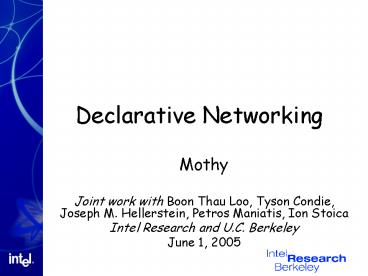Declarative Networking - PowerPoint PPT Presentation
1 / 17
Title:
Declarative Networking
Description:
Off the top of my head... Running packet networks remains a complex and ... I find this astonishing. Can someone correct me? It's not all been wasted... – PowerPoint PPT presentation
Number of Views:41
Avg rating:3.0/5.0
Title: Declarative Networking
1
Declarative Networking
- Mothy
- Joint work with Boon Thau Loo, Tyson Condie,
Joseph M. Hellerstein, Petros Maniatis, Ion
Stoica - Intel Research and U.C. Berkeley
- June 1, 2005
2
Off the top of my head
- Running packet networks remains a complex and
difficult problem. - Despite 25 years of research, no abstractions
have emerged to modularize the problem. - I find this astonishing. Can someone correct me?
3
Its not all been wasted
- Lots of measurement
- ? lots and lots of data now
- Understand network level well
- TCP, BGP, Malware, etc.
- Plenty of control mechanisms
- DCAN, RCP, 4D, etc., etc.
- Hypothesis for IP at least, we as researchers
already understand this well enough to abstract
and uplevel. - Can we just move on?
4
Mental exercise
- For a moment, try to forget everything you know
about BGP, OSPF, IS-IS, DVMRP, etc., etc. - Take a deep breath or two.
- Doesnt that feel good?
5
A different abstraction
- The set of routing tables in a network represents
a distributed data structure - The data structure is characterized by a set of
ideal properties which define the network - Think in terms of structure, not protocol
- Routing is the process of maintaining these
properties in the face of changing ground facts - Failures, topology changes, load, policy
6
Routing and Query Processing
- In database terms, the routing table is a view
over changing network conditions and state - Maintaining it is the domain of distributed
continuous query processing
7
Distributed Continuous Query Processing
- Relatively new and active field
- SDIMS, Mercury, IrisLog, Sophia, etc., in
particular PIER - ? May not have all the answers yet
- But brings a wealth of experience and knowledge
from database systems - Relational, deductive, stream processing, etc.
8
Goal a constrained declarative language for
network specification
- Higher-level view of routing properties
- More than simply a configuration language
- Modular decomposition of function
- Static analysis for
- Optimization techniques
- Safety checking
- Dynamic optimization
- C.f. eddies, etc.
9
Other advantages
- Can incorporate other knowledge into routing
policies - C.f. Jennifers examples, and beyond
- E.g. Physical network knowledge
- Naturally integrates discovery
- If you buy Pauls argument
- Also provides an abstraction point for such
information - Knowledge itself doesnt need to be exposed.
10
What are we doing, then?
- Express network properties in DataLog
- Preliminary to better languages
- Execute specifications to maintain routing and
discovery - Two directions / implementations
- IP Routing (SIGCOMM 2005)
- Overlays (under submission)
11
Why overlays?
- Overlays in a very broad sense
- Any application-level routing system
- Email servers, multicast, CDNs, DHTs, etc.
- Ideal test case
- Clearly deployable short-term
- Defers interoperability issues
- The overlay design space is wide
- ? ensures we cover the bases
- Testbed for wider applicability
12
A Declarative Overlay Engine P2
- Everything is a declarative query
- Overlay construction, maintenance, routing,
monitoring - Queries compiled to software dataflow graph and
directly executed - System written from scratch (C)
- Deployable (PlanetLab, Emulab)
- Already has reasonable performance for deployed
overlays
13
P2
DataLog
Software Dataflow Graph
Received Packets
Sent Packets
14
Example Chord in 33 rules
15
Comparison MIT Chord in C
16
Conclusion
- An abstraction and infrastructure for radically
rethinking networking - One possibility System R for networks
- Where does the network end and the application
begin? - E.g. can run queries to monitor the network at
the endpoints - Integrate resource discovery, management, routing
- Chance to reshuffle the networking deck
17
Thanks.































